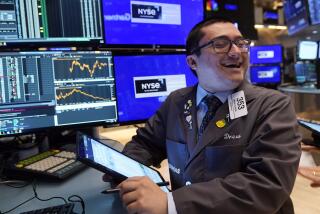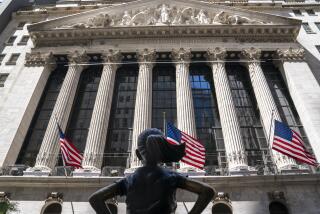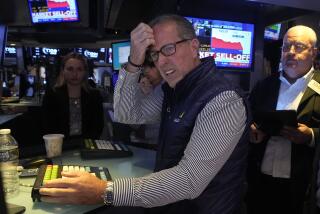Tokyo Stocks Were Due for Fall Before Crisis, Analysts Say
- Share via
TOKYO — The Japanese stock market has taken a solid drubbing from the uncertainty over the Persian Gulf crisis, but the bad news about higher oil prices and a possible shooting war may have only precipitated the kind of earthward correction that was coming anyway.
Prices on the Tokyo exchange went into a free fall earlier last week, with the Nikkei stock average shedding more than 10% of its value in trading Wednesday and Thursday. After losing ground during six straight trading days, the market rebounded moderately Friday. But the outlook remained gloomy.
There is no question about the immediate cause of this bearishness: The situation is heating to a boil in the Middle East, from which Japan’s energy-dependent economy receives about 70% of its oil imports.
But analysts say the technical underpinnings of the decline were in place long before the Iraqi army rolled into Kuwait on Aug. 2. There was, in fact, an unnerving preview of the collapse of the market in early April, when anxiety over such non-military menaces as rising interest rates and softening bond prices sparked a major selloff.
Basically, share prices were far too high to begin with, after several years of hyper-growth that catapulted the Tokyo Stock Exchange into the No. 1 position in the world in terms of total capitalization. Corporate earnings didn’t come close to justifying the astronomical prices, but the conventional wisdom in Japan was that the absence of orthodox value didn’t really matter. It was a bubble waiting to burst.
“What’s happening is a liquidation after a long period of overheating,” said Osamu Tanaka, president of NB Investment Technology, a Tokyo-based investment advisory firm. “It would have happened last year, but the imbalance of demand and supply distorted fundamentals.”
In the heyday of what analysts already are remembering fondly as Tokyo’s “super bull market,” stocks went sky high in an investor environment blessed with the “triple merits” of low interest rates, cheap oil and strong yen. Corporations and institutional investors were laden with huge amounts of cash that invariably found its way into domestic stocks, pumping up share prices and creating the illusion that the Nikkei would climb forever.
The stock mania peaked at the end of last year, with the index reaching 38,915. When the market hit bottom Thursday at 23,737.63, it had lost more than 15,000, or 39%, from the peak.
In terms of total capitalization, the Tokyo Stock Exchange had fallen again to the No. 2 place behind the New York Stock Exchange. About $1.3 trillion in assets had vanished.
The losses in August have been most dramatic.
“A lot of fund managers are going to have serious headaches when they report their performances to clients,” Tanaka said. “But they’re lucky in a way; they can blame it all on Saddam Hussein.”
There are various and conflicting scenarios on where the Tokyo market may go from here, but serious observers are not predicting a return to the old frothiness soon. Interest rates must come down to reduce what the experts call the “yield gap” between the return on investments in stocks and in bonds.
And despite the overall robustness of the Japanese economy and the consensus that it will be comparatively resilient to an oil shock, time will be needed to repair delicate investor psychology. Military tension in the Persian Gulf region plays on visceral fears of Japanese vulnerability.
“The market will remain out of control as long as there are unresolved variables in the Middle East,” said Darrel Whitten, director for Japanese research at Prudential-Bache Securities (Japan). “You can’t predict how long a war could last. If uncertainty prevails, share prices will continue to fall until the market finds its support level.”
Estimating where the bottom might lie involves a blend of technical analysis, chart reading and guesswork. The bad news Thursday was that the Nikkei slipped right through its five-year average of about 25,300. Now the line in the sand for Japanese stocks is being drawn at 22,000 or 21,000, about where it hit bottom after the Black Monday crash in late 1987.
Whitten notes that in the Tokyo market’s several major cycles since the end of World War II, the “corrections,” or drop from peak to bottom, have been in the 20% to 44% range, meaning that the worst may be over. But it also took from one to four years for share prices to regain healthy growth, he said.
Moreover, Finance Ministry officials have lost much of their ability to steer the market with the easing of market regulations since the mid-1980s. Futures and options on the Nikkei average that are traded in offshore markets now have an unpredictable--and uncontrollable--effect on stock prices in Tokyo.
Yet authorities played their hand Friday and took partial credit for the end-of-the-week rally. Tokyo Stock Exchange officials tightened regulations on speculative futures trading, and the Finance Ministry lifted a rule that barred brokerages from trading more than 30% of the total volume for any specific issue in a month.
The latter rule had been intended to thwart price manipulation--which officials undoubtedly would like to see a little more of for now, providing that the direction is up.
More to Read
Inside the business of entertainment
The Wide Shot brings you news, analysis and insights on everything from streaming wars to production — and what it all means for the future.
You may occasionally receive promotional content from the Los Angeles Times.










